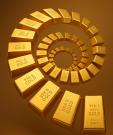Gold Price Dives Again As Dollar And Stocks Make A Recovery
Another day and yet another episode in the great gold/markets/dollar/renminbi saga. While the Shanghai Composite Index fell another 1.3%, and Hong Kong's Hang Seng Index was also down around 1%, Japan's Nikkei and European and American markets were all picking up strongly after a week of almost continual red ink and some better US consumer confidence figures. However, markets are extremely volatile at the moment - take yesterday's activity in the Dow swinging from a strong upturn at the opening and through most of the day before swinging into a complete reversal at the end, falling over 200 points by the day's end.
The latest moves were because of, or in spite of, in respect to the Chinese and Hong Kong markets, the Peoples Bank of China (PBOC) announcing a twin-pronged easing in lowering interest rates and raising the reserve requirement ratio for most of the major banks.
With the dollar rising fairly sharply after several days of decline, the gold price has been the major sufferer with what looks like the gold bears taking advantage of a perceived hole in the yellow metals' armour and driving the price down below $1120 - a level last seen over a week ago - before making something of a recovery as the day has progressed. But in the current markets it looks like anything could happen - they appear to be totally unpredictable at the moment. One suspects markets will remain extremely volatile in the days and weeks to come as banks, funds and investors digest moves and counter moves by the globe's big economic players.
Some might say forewarned should be forearmed and there had been forecasts from as long as three years ago (See: What China is really doing to rebalance. All not as generally perceived) that China was in the process of planning a virtually total reboot of its economy from being export driven to a domestic consumer society and that this process might be an extremely painful one domestically - as it has proven to be already. However, the key is perhaps employment levels and a big resultant rise in unemployment may cause panic buttons to be hit. Interestingly the Chinese had been promoting gold and silver investment to its ever growing middle class populace as being perhaps a safer haven against the coming internal financial upheavals and despite gold's lackluster performance over the past four years, the recent stock market downturns may have reinforced the metal's comparative safety.
But the Chinese stock market collapses have generated fear outside China that the same could happen elsewhere, and the Dow and S&Ps falls this year - and the huge downturns of last week and early this - may have brought this lesson home. In China the seemingly inexorable stock market rise which preceded the massive downswing was drawing the gambling Chinese into the markets as though they could not go wrong. Much of this money going into the markets was reportedly on margin which means the falls made investors doubly vulnerable and the falls may not have ended yet despite moves by the PBOC to prop things up.
But surely American investors should be learning from the Chinese debacle - but it seems not. Here again much of the growth has been built on margin which accounts for a lot of the fear which is currently striking the markets. Investors need to be wary that the apparent recovery today, could like yesterday's, be short-lived.
Paradoxically one would have thought that gold might have benefited through its potential safe haven appeal. While the withdrawals from the big ETFs seem to have ceased, at least for the moment - indeed we have been seeing inflows again - the price has still fallen back from its recent surge level. ABN Amro analysts put this down to gold more and more being seen as a speculative investment which runs counter to its previous safe haven status and is thus as vulnerable to almost as big fluctuations as the markets.
But while China is rebooting its economy, with the painful consequences noted, it is also almost desperate to have the yuan included in the IMF's SDR to confirm its status as a potential reserve currency, and moves intended to assist this may also be seen as a sign of the weakening of the massive Chinese economy. Add these two factors together and the effect can be dramatic as we have seen in the Chinese and Hong Kong stock markets in particular. And nowadays what happens in one part of the world is almost inextricably tied to markets elsewhere. Markets do not operate in a domestic vacuum any longer.
So what happens next? Is the recovery in Western markets sustainable. We're not sure. The dollar resurgence could prompt further devaluation of the yuan and given it was perhaps the initial yuan devaluation which initiated the big recent falls, a further such move could possibly see it all happen over again. Maybe it's worth staying out of the stock market for the moment. The long-predicted crash has already happened in China and arguably may have begun also in the Americas and Japan. We wouldn't like to take odds against further big falls being in the offing and if so investor panic. Coupled with algorithmic trading, could drive them into a free-fall.
********
Courtesy of http://lawrieongold.com/






 Lawrence (Lawrie) Williams has been involved with both the technical and the financial end of the mining sector for over 40 years, formerly CEO of top mining industry business publisher, Mining Journal Limited, he was Mineweb's General Manager and Editorial Director up until October 2012 and is now Consultant Editor. He has worked as a mining engineer on gold, platinum, uranium and copper mining operations.
Lawrence (Lawrie) Williams has been involved with both the technical and the financial end of the mining sector for over 40 years, formerly CEO of top mining industry business publisher, Mining Journal Limited, he was Mineweb's General Manager and Editorial Director up until October 2012 and is now Consultant Editor. He has worked as a mining engineer on gold, platinum, uranium and copper mining operations.










